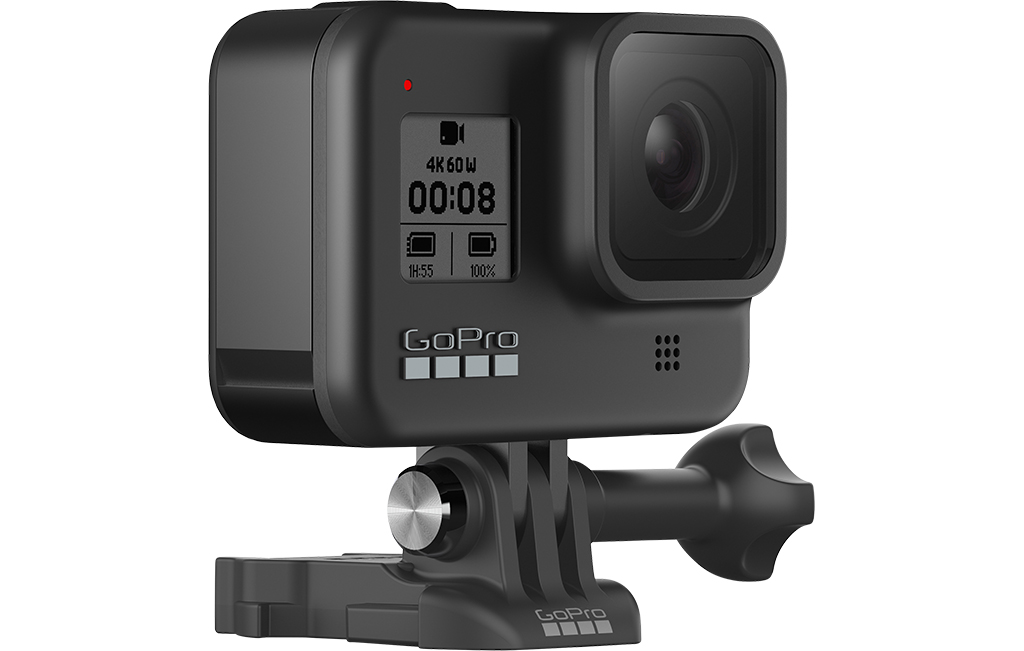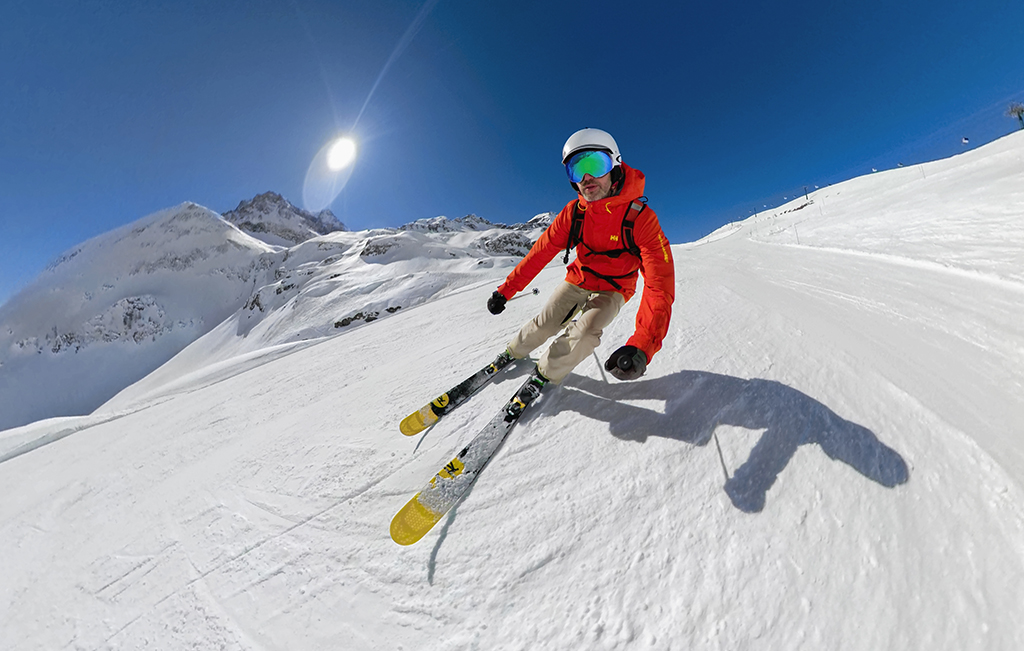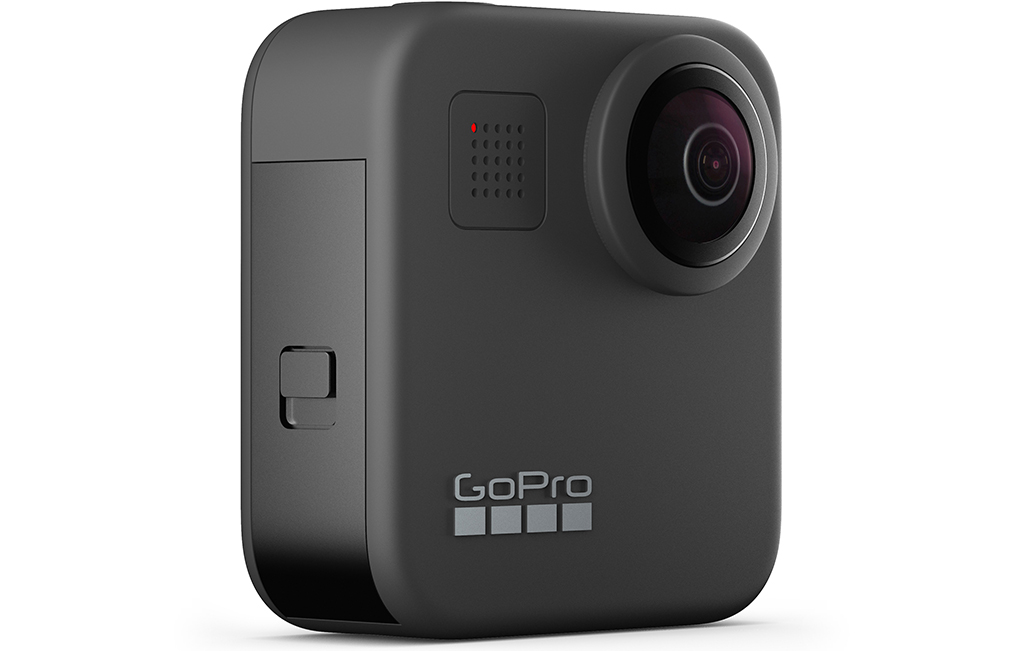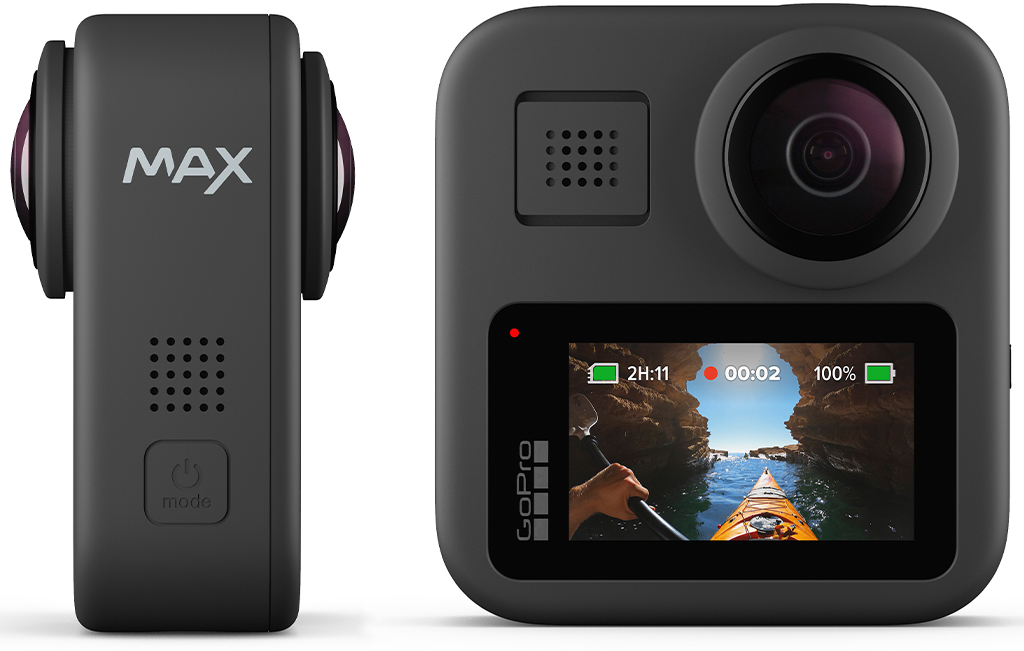Like most (all?) tech, action cameras keep getting better every year. So it used to be that the best available option was the newest model, but with last year’s releases of both the GoPro HERO8 Black and MAX cameras, adventurers have two current models to choose between.
We’re here to help you make that decision.

HERO8 Black ($400)
The GoPro HERO series has come a long way since it was introduced in 2004 as a compact 35mm that strapped to a surfer’s wrist. Now digital and a little smaller, the newest HERO has a touch display, image stabilization, four different photo views, burst photos, time-lapse video, live streaming, voice control and more. That’s a whole lotta goodness packed into one tiny action camera.
Below are the key new features of the HERO8, including formfactor changes and image product upgrades.
Formfactor Changes
New Size
While the HERO8 is very close in size to its predecessor, the HERO7 (which was the same size as the HERO5 and HERO6, too), it’s slightly taller and skinnier. We don’t expect this to be a big deal for anyone new to the GoPro family, but it may be a bummer for anyone who has invested in size-specific accessories like protective housings and dive covers.
Sealed Lens
The HERO8 Black reverts back to the style of the earliest GoPro cameras with a completely sealed lens. (The HERO5, 6 and 7 cameras had replaceable lenses that weren’t sealed.) This helps prevent moisture from seeping between the lens and outer glass and creating condensation, but the trade-off is that you can’t replace the outer glass if it gets chipped or scratched. So, while the HERO8 is less repairable, the lens does better at ensuring unobstructed image quality.
GoPro provides a few ways to negate the vulnerability of the HERO8’s irreplaceable lens. First, there’s the $5 per month GoPro PLUS subscription service, which promises a camera replacement if the lens is damaged. Second, there are extras like the Protective Housing ($50) that can boost durability.
Built-in Mount
New for the HERO8, the mounting system is built into the camera. That means you don’t need a frame or housing anymore; just fold out the two fingers from the bottom of the camera and affix to any standard mount. The mounting system is flush against the camera body and easy to pop out. But though the design is slick, it introduces more moving parts, and it’s not quite as stable as having fixed fingers. Still, if one of these fingers does snap off, it’s easily replaceable ($20).
One Access Door
GoPro combined the access to the battery, SD card and charge port behind one door that opens from the side of the camera (there is no HDMI port like on the HERO7). This makes it much easier to change the battery or SD card while leaving the camera on whatever mount you’re using. It also lets you plug the camera into an external power source while you’re using it for more prolonged filming. (The metal door is entirely removable, which allows external-power plugs to fit, but makes it easy to lose. The camera is no longer waterproof without this door. GoPro sells door replacements for $20.)
Battery
The HERO8 Black uses a battery that’s the same size and shape as its predecessor, but it’s ever so slightly more powerful (it also draws more power than its predecessor, giving it an identical 1,200 mAh). That means the camera is compatible with older batteries, but you’ll notice a warning on the camera that it may not be able to perform as intended. We didn’t notice any performance drops in our testing. The new battery can be used in models back to the HERO5, as long as the camera’s firmware is updated.

Image Product Upgrades
HyperSmooth 2.0
New in the HERO8, HyperSmooth, the camera’s gimballike stabilization, works in all resolutions and frame rates. This is most noticeable in good lighting, when you have a higher shutter speed. In overcast weather or in a thick forest, however, the lower shutter speed required for low-light filming provides less data for the HyperSmooth software.
Another key improvement of HyperSmooth 2.0 is that it’s offered in 1080p at 240fps (slow motion). The HERO7 Black only offered standard stabilization for up to 140fps. In other words, if you shoot a lot of slo-mo video, you should take a flyer on the HERO8.
Front-Facing Microphone
New in the HERO8, there’s a microphone on the front of the camera—perfect for selfie-style videos. As with its predecessor, the camera also has mics on the sides and bottom (the HERO7 had mics on the sides and top). The HERO8 also has a wind mode that effectively eliminates wind noise from the camera’s audio.
Improved HDR in SuperPhoto
GoPro’s automatic photo setting, called SuperPhoto, analyzes the scene and intelligently selects the best image processing for your photo. It automatically chooses between High Dynamic Range (HDR), local tone mapping, multi-frame noise reduction and no processing. New in the HERO8, the updated SuperPhoto function has better HDR for sharper photos that have higher contrast and reduced motion blur.
TimeWarp 2.0
Remember HyperSmooth? The TimeWarp function takes that stabilization technology and applies it to TimeLapse video. But now, with 2.0, the camera can automatically detect the necessary frame rate for your shot. (You can manually adjust this.) The HERO8 also offers a mode for shooting time-lapse videos at night.
Narrow Field of View
The HERO8 offers one new field of view: Narrow, which is pretty much a zoom lens (described as the equivalent of 19-39mm). It still has the other three fields of view from the HERO7: SuperView, Wide and Linear.
Shooting Profiles
Much of the GoPro menu system was updated from the HERO7. But the best part, we think, is the preset shooting profiles. GoPro preloads the camera with four profiles:
- Standard (1080p | 60fps | Wide)
- Activity (2.7K | 60fps | SuperView)
- Slo-mo (1080p | 240fps | Wide)
- Cinematic (4K | 30fps | Linear)
It’s easy to toggle between the profiles, and each of them can be manually edited and customized to suit each user’s needs. GoPro also provides the ability to create completely new profiles. (Minor gripe: You can’t name your custom preset; you have to choose from a set that includes things like “air,” “epic” and “trail.”)

GoPro MAX ($500)
Shortly after the release of the HERO8 in October 2019, GoPro announced a new 360-degree camera: the MAX. The MAX replaces the Fusion, GoPro’s original self-contained spherical camera released in 2017.
A spherical camera captures the scene all around the camera, allowing you to publish 360-degree photos or videos on interactive and immersive platforms. With a camera like this, you don’t have to frame your shot because the camera picks up everything. (If you just want a standard photo or video, you’d need to pull it from your 360-degree footage in post-production or in the GoPro mobile app.)
Here are the notable features of the MAX, including formfactor, photo and video quality and control.
Formfactor
The MAX is like two HERO8 Black cameras in a single housing that’s close to square at 64 by 69 mm (or 2.51 by 2.62 inches) and 25 mm (or 0.98 inch) wide. It’s roughly three-quarters of an inch taller than the HERO8 and waterproof down to 16 feet.
Like the HERO8, the MAX has retractable mounting fingers that are compatible with all GoPro mounting accessories. It has a small touchscreen on the back and uses the same software and menu system as the HERO8. Also like the HERO8, the lenses on the MAX cannot be replaced, but they’re protected by removable caps when not in use. (If you subscribe to the GoPro PLUS service, GoPro will replace damaged cameras up to twice a year.)
Like the HERO8, a single access door covers the battery, SD card slot and USB-C charging port. (The MAX uses a different battery than the HERO8; they are not interchangeable.)

Photo and Video Quality
The MAX has many of the same photo and video features and capabilities of the HERO8. In fact, if you flip the MAX into Hero mode, it acts as a HERO8, using one of its lenses instead of both. The software is much the same, as well.
There are a few notable differences to consider. The MAX lacks presets like the HERO8, preventing you from flipping between user preferences and styles. The MAX cannot shoot 4K in Hero mode like the HERO8. It tops out at 1440p at 60fps when using a single lens. (When shooting 360 degrees at 30fps, the MAX cranks out 5.6K resolution.) Additionally, the MAX can only shoot 2x slo-mo (the HERO8 can shoot 8x). It also doesn’t have a raw image capture mode, LiveBurst or night lapse video.
The MAX does, however, have a 270-degree photo mode (called PowerPano) that allows you to snap neat panoramic photos using both lenses. It also has MAX HyperSmooth video stabilization, MAX TimeWarp video, MAX SuperView wide-angle shots and six microphones for surround sound. The MAX, which has three more mics than the HERO8, is decidedly better at filtering out wind noise, too. (We were able to filter it out in 25mph gusts.)
Control
A major improvement of the MAX over the former Fusion and other spherical cameras is the ability to use the GoPro app to reframe both photos and videos, edit 360-degree video (by selecting pans and follows) and export footage to share on social media platforms either as flat or spherical. (You can use desktop software for more capabilities.)
